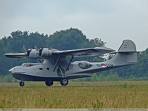|
Consolidated PBY-5 Catalina
 From its introduction to U.S. Naval service in 1936, through its continued international military use into the 1970`s, to the recent retirement of the last civilian fire-bomber, the Consolidated PBY Catalina has served a distinguished career as one of the most rugged and versatile aircraft in U.S. history. It was created in response to the U.S. Navy`s 1933 request for a prototype to replace the Consolidated P2Y and the Martin P3M with a new patrol-bomber flying boat with extended range and greater load capacity. From its introduction to U.S. Naval service in 1936, through its continued international military use into the 1970`s, to the recent retirement of the last civilian fire-bomber, the Consolidated PBY Catalina has served a distinguished career as one of the most rugged and versatile aircraft in U.S. history. It was created in response to the U.S. Navy`s 1933 request for a prototype to replace the Consolidated P2Y and the Martin P3M with a new patrol-bomber flying boat with extended range and greater load capacity.
The new design introduced internal wing bracing, which greatly reduced the need for drag-producing struts and bracing wires. A significant improvement over its predecessors, it had a range of 2,545 miles, and a maximum take-off weight of 35,420 lbs. In 1939 the Navy considered discontinuing its use in favor of proposed replacements. The Catalina remained in production, however, because of massive orders placed by Britain, Canada, Australia, France, and the Netherlands. These countries desperately needed reliable patrol planes in their preparations for WW II.
Over the years, numerous improvements were made to the design. An amphibious version, the PBY-5A, was developed in 1939, through the addition of a retractable tricycle undercarriage
A total of approximately 4000 Catalinas were built between 1936 and 1945. Because of their worldwide popularity, there was scarcely a maritime battle in WW II in which they were not involved. The PBY had its vulnerabilities: it was slow, with a maximum speed of 179 mph, and with no crew armor or self-sealing tanks, it was highly vulnerable to anti-aircraft attack. However it was these weaknesses, coincident with the development of effective radar, and Japanese reliance on night transport, which led to the development of the "Black Cat Squadrons." These crews performed nighttime search and attack missions in their black-painted PBYs. The tactics were spectacularly successful and seriously disrupted the flow of supplies and personnel to Japanese island bases.
Specifications, PBY-5A:
Engines: Two 1,200 hp Pratt & Whitney R-1830-92, twin wasp radial piston engines
Weight, takeoff (lbs): 35,420
Wing Span (feet): 104`0
Length (feet): 63`10
Speed (mph): 179
Ceiling (feet): 14,700
Range (miles): 2,545
Armament: 5*7.62mm (0.3-inch) machine guns, up to 4,000 pounds of bombs or depth charges
Back to History Index
 |
Bahamas, The |
1995 |
PBY-5A Catalina flyigboat on anti-sub' patrol |
 |
Marshall Is. |
1998 |
PBY-5 Catalina over a submarine |
 |
Saint Lucia |
2003 |
Consolidated Catalina PBY-5A over a submarine |
|